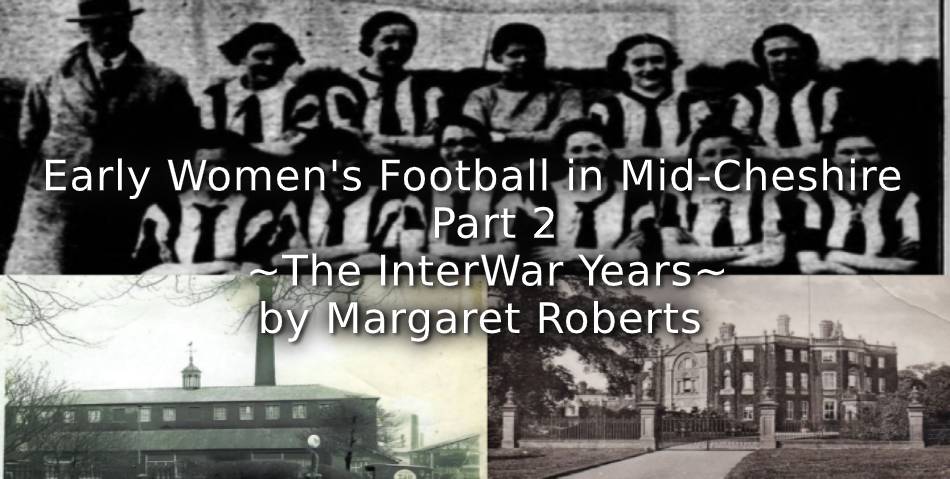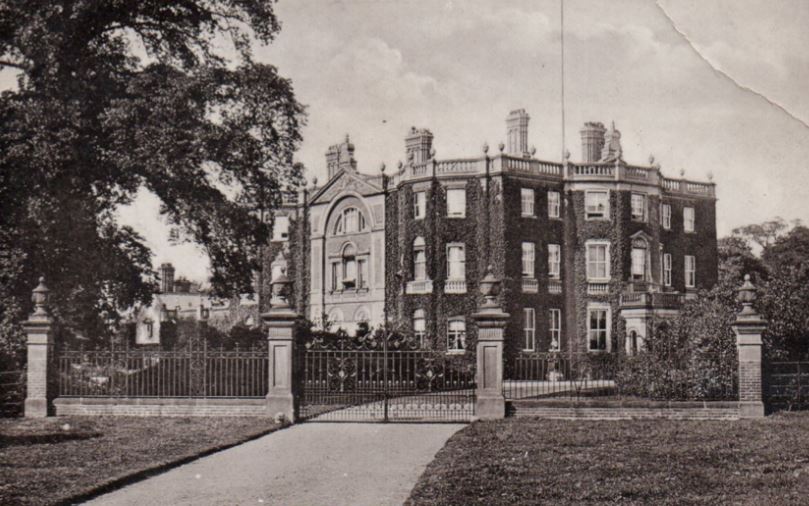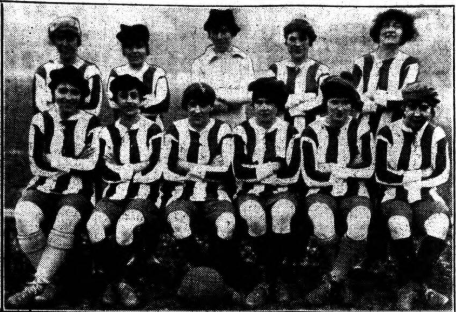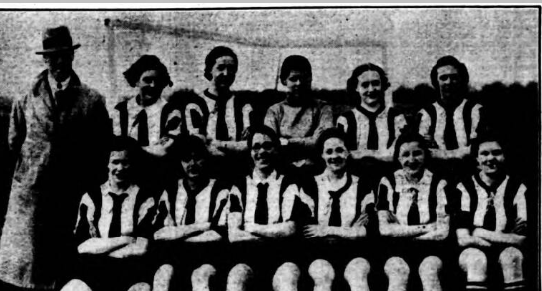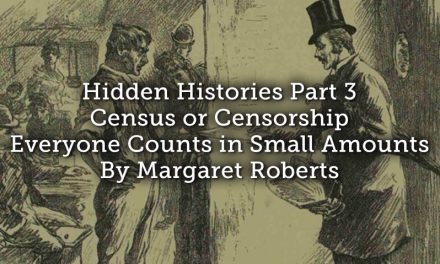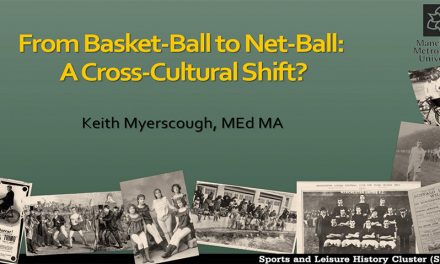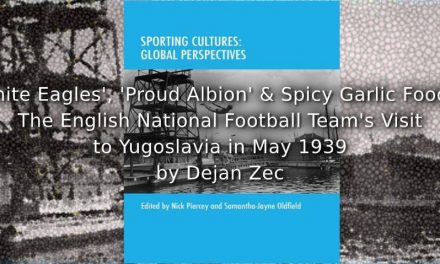As was seen in Part 1 [Click HERE to read} of this series the women footballers of Mid-Cheshire were mostly Munitionettes teams from the local works such as Electro-Bleach, Middlewich Salt Co, Verdin and Cooke and the Lostock Munition Works. These women played matches against each other for local charities, particularly those connected with the Red Cross effort; the games attracted large crowds, with a fierce partisan rivalry evident among spectators and players alike. The local newspapers extensively reported these early games, with many column inches recording the events with hint of hilarity and a lot of condescension which may now, to the modern reader, seem very patronising.
After the War, with the return of the men from the front and the 1919 Restoration of Pre-War Practices Act, many women had to give up their employment in the factories and return to their pre-war occupations. This had a drastic knock-on effect on their ability to continue to play football, as many of the teams quickly started to drift apart, eventually disbanding altogether; the situation further compounded by the widespread movement to encourage the women to return to domestic duties. The view of women’s football also started to alter, the previous rationale, that it was not only an appropriate way for factory workers to spend their leisure time, being as it was, advantageous for their health, but that is was also a boon for the national morale, soon began to appear less relevant. Dr Mary Scharlieb of Harley Street, in supporting the 1921 resolution of the patriarchal Football Association (FA) in their request to football clubs to refuse the use of their grounds to women footballers, condemned the sport as ‘a most unsuitable game, too much for a woman’s physical frame.’
The women’s game however did continue, on grounds not under the jurisdiction of the FA, such as rugby and cricket fields. Prominent among the Cheshire teams that continued playing, at least in the early years of the inter war period, was the team from Verdin and Cooke, who appeared in several charity matches between 1920 and 1921, often against the most well-known team of the period, Dick, Kerr’s Ladies of Preston. Verdin and Cooke’s was also referred to as Middlewich Ladies in the press and there is strong evidence that the women were also called Cheshire Ladies, Mid-Cheshire Ladies and sometimes even West-Cheshire Ladies; research is ongoing to establish this fact by liaising with the families of the players mentioned in the team lists published in contemporary newspaper reports. One of the first post-war games played in the area was between Mid-Cheshire Ladies and Dick, Kerr’s. The game took place at Bostock Hall, Winsford, on 12 June 1920, which Dick, Kerr’s won 5-0. A silver cup, reportedly valued at some £25 was presented to the victorious team by Mr F. R. Harden-Jones. See Part 1 for the involvement of Harden-Jones in the game locally.
- Bostock Hall
The following month, Dick, Kerr’s were back in the locality, when they appeared at the Crewe Alexandra ground on 26 June, taking on the ‘champion Cheshire team’, Verdin Cooke Ladies; the money raised from the proceeds of the match were to be presented to Crewe Cottage Hospital. According to the Crewe Chronicle a few days later the hospital benefitted by some £400; whether this is the true figure or not is in doubt, as the Lancashire Evening Post gave an exact figure of £227 5s, while also noting that there was a gate of some 5,000. Dick, Kerr’s were said to have given a ‘sparkling display and proved themselves much the smarter side, winning 3-0.’ The team were presented with a silver cup by the Crewe Hospital Fete Committee. Lostock Hall near Winsford was the venue for yet another encounter between Dick, Kerr’s and Mid-Cheshire Ladies in August 1920. In a season opener for the Preston team, in which their ‘footwork delighted the crowd’, they won 3-0. The following week, the Verdin and Cooke’s Ladies, also referred to as Cheshire Ladies, travelled to Chorley to meet Dick, Kerr’s, the charity match in aid of the Chorley and District Discharged Sailors and Soliders Club raising between £40 and £50 and, resulted in another defeat for the Cheshire team.
Verdin and Cooke’s women apparently seemed to be gaining creditability as a viable team when they were involved in the ‘Event of the Season’, the return of Dick, Kerr’s ‘International Football Team’ to Turf Moor, Burnley. The match, in aid of Burnley Cricket, Bowling and Tennis Club, was played on 23 November, with Verdin and Cooke’s being touted as the ‘Champions of Cheshire’. The game aroused a lot of interest and a large crowd was expected; the match tea, to be served in the Cricket Club Pavilion by the ladies of the Tennis Club was to be followed by an evening of social events. The eventual gate money was reported to be in the region of £300 and the match itself saw the Preston side faster and more skilful than their Cheshire counterparts, who defended well but whose forwards failed to make any headway, and did not trouble Miss Hastie in goal, who was not called upon to make a single save in their 7-0 victory.
-
Verdin and Cooke’s Ladies
Source: Burnley News
The final match of 1920 for Verdin and Cooke’s, again against Dick, Kerr’s, was held at the Seedhill Ground in Nelson on 11 December. Both teams were noted as having raised a great deal for charity and this particular ‘attractive fixture’ was in aid of the new extension for the Nelson Football Club with the Nelson Cricket club professional, Mr G. Geary acting as referee. The Preston women found ‘goal-getting an easy matter’ in winning 12-0, showing, according to the Lancashire Evening Post reporter, an excellent knowledge of the game, while the Cheshire side, although hard workers, were lacking skill and could not ‘swing the ball about’ in the same manner as their more experienced adversaries. Miss J Crawford, the centre-half, was singled out as the best player for the Middlewich side, which also featured many names that had also played in the Verdin and Cooke’s Munitionette team of earlier years. The eventual gate receipts were stated to have been shared between the Nelson club’s ground extension fund and a local charity.
The women of Verdin and Cooke’s carried on in a similar fashion for much of 1921, with a match against their old rivals from Lancashire at the Cobridge Cricket Ground in Staffordshire, hosted by Burslem Cricket Club on 5 March. With neither Port Vale or Stoke City playing at home that day a big crowd was expected, with accommodation for 4,000 in the reserved section and up to 10,000 in the unreserved enclosure. A keen rivalry was said to exist between the two teams with Cheshire Ladies ‘determined to lower the colours of their opposition’. One third of the net profits of the game were to be devoted to the North Staffordshire Infirmary. Under the headline ‘Stirring Battle of the Amazons’, the Staffordshire journalist ‘Nimrod’ was effusive in his language; the display of ‘muscular femininity’ provided by the Dick, Kerr’s eleven, should, he said, have been witnessed by ‘10,000 or more had the weather not been so threatening’. As it was, the crowd was disappointing, which proved not to be an onerous task for the many constables that had volunteered their services as stewards. Cheshire Ladies, playing in their familiar red stripes, often bought forward cries of ‘Play up Stoke’, which caused some amusement among the spectators, but this support failed to help the Cheshire side, who once again lost 12-0.
West Cheshire Ladies, more than probably the Verdin and Cooke’s team, played St Helen’s Lades on 28 March at Walsall, before a large crowd of 8,000. St Helen’s completely outclassed the Cheshire women, scoring 16 goals to a single one in reply. On 21 April 1921, the Cheshire Ladies team were due to play in what was reported at the time as the ‘first ladies football match to be seen in Birmingham’, pitted against St Helen’s Ladies, The game was expected to be a big attraction and was organised in order to raise funds for Father Hudson’s Homes. However, ‘owing to transport and other difficulties’, the Cheshire team were unable to appear and were replaced at the last minute by Stoke Ladies. The match was cancelled so late that the medals struck for the game and presented to the players still bore the Cheshire County Crest. It can only be speculated as to what the ‘other difficulties’ entailed but Verdin and Cooke’s Ladies’ seem to have folded by the end of the season.
The Drill Field in Nantwich, was the venue when Middlewich (Verdin and Cooke’s) met the team representing the Preston textile factory Horrockses Crewdson and Co on 4 June. ‘ Curiosity as well as sport” was said to have attracted a good proportion of the crowd, as the ‘sight of fine and “hefty” maidens in football knickers and jerseys has not yet begun to pall.’ The NSPCC were the better for over £100 by the end of the game, which was won by Middlewich by a goal to nil, even though they were handicapped by a number of important absentees and despite the fact that the Preston side fielded some very experienced players, included their captain, who played for Dick, Kerr’s when they toured France, while four other members of the team had represented Lancashire.
Other women’s teams were being fielded within the Mid-Cheshire to raise money for various causes, with many a newspaper snippet mentioning their exploits. Once such case was the Upton Ladies, near Chester, who, in April 1921, held a ‘delightful dance’ for the benefit of their own funds. The club had been formed by, and was managed by, the women themselves, who had thus far been able to buy their jerseys and hoped soon to have the funds to buy the rest of the outfit. The players hoped that more would soon join them, enabling two sides to turn out on a Saturday afternoon, and once they had a ‘full outfit’ they would be able to arrange matches with other ‘ladies’ teams in the vicinity’ and eventually take part in matches for different charities.
Crewe found itself at the centre of women’s football in June 1921 when Dick, Kerr’s Ladies returned to play a ‘Grand International’ match against Wales, represented by Swansea Town Ladies’ FC, in aid of the Crewe Cottage Hospital; it was stated the Dick, Kerr’s were the holders of the Crewe Fete Competition Cup, the new name for the cup presented to the side the previous year by Mr F.R. Harden Jones. The Welsh side were defeated 8-0, concluding a successful season for the Preston women, who returned home with two cups, the aforementioned Crewe Cottage Hospital Cup, having successfully defended it, and the Ex-Service Men’s Cup, which was presented to them in recognition of their great services to the Ex-Service Men’s cause.
Ladies football was obviously dealt a blow with the ban on the use of FA grounds by women players coming into force in December 1921 but there was nothing to prevent the women playing on grounds outside the jurisdiction of the FA. Many smaller factory and work sides began to form within Cheshire, some on an ad hoc basis, again playing for various charities and local causes. Saltney Ladies, for example, who played in what was reported as the first ever women’s football match to take place at Garston on Tuesday 27 December, at the Avenue Cricket Ground, attracted a gate of over 3,000 spectators. The match against Garston Ladies, to raise funds for the Garston Voluntary Relief Committee Soup Kitchen, was won by Saltney 2-0. The teams met again in January at Saltney on the Cavendish Road Ground at Hough Green, near Chester. A cold and damp day, with snow on the roads, which caused the Garston coach to arrive late, did not deter a crowd of between three and four hundred to gather to watch Saltney win 1-0, with the proceeds towards the local unemployed.
Women’s football seems to go a little quiet in the area for a couple of years with no reports to be found in the local press. Matches were by now few and far between and indeed it was not until July 1925 when Nantwich Football Club announced that as a means of raising funds for the following season, Dick, Kerr’s Ladies team would be in attendance at a sports day arranged for September, when they would play against a Lancashire XI at the Kingsley Fields Cricket Ground in the town. A considerable crowd of spectators were thrilled to see Dick, Kerr’s assert their knowledge of the game and win 11-0. A much smaller, but ‘interesting’ game was witnessed in a tournament for a miniature silver challenge cup that took place at Malpas in July 1928. Teams representing the Cheshire village of Malpas and nearby Grindley Brook, who fielded a player over 70 years of age, played a match of fifteen minutes each way, Malpas winning by the only goal of the game, scored by Miss McClaren. The other match in the tournament was won by Hampton Ladies, defeating Maesfen Ladies 2-1, with Malpas winning the final and claiming the trophy, which was presented by Lady Kenyon.
Women’s football once again goes rather quiet in Mid-Cheshire until 1934 when the ‘girl enthusiasts’ of Wheelock, Sandbach, in the form of a team from the Zan Aluminium Works, were reported to have played a team of ‘Rivals’. The match, to help the funds of the local Nursing Association attracted a crowd of about 350, the number of cars being so great that Mr Fred Holland had to be prevailed upon to provide another field as a car park. The ‘Rivals’ defeated the ‘sturdy’ Zan players, who although defeated, proved themselves to be ‘no mean exponents of the game’, by two goals to nil,/ The Zan team’s enthusiasm was dampened for a while by the unfortunate loss their goalkeeper to injury but they were hopeful of having their revenge in the next fixture and intended to go into ‘strict training’.
- Zan Works Circa 1915
A little snippet in the Cheshire Observer also notes that in August the Malpas Ladies were in action once more, playing a team from the small village of Worthenbury for funds for the Jubilee Hall. June 1936 saw a Garden Party held at The Vicarage in Sandbach feature a ‘Ladies Football match’ as one of the attractions, but no further mention is made of this. Due to current restrictions, the author is unable to research the local Sandbach newspapers, where it is expected there will be more information on the games played in the Sandbach area.
Zan Ladies once again took to the football arena on Easter Monday in April 1938, when they met the Premier Ladies of Coppenhall, Crewe, on the Crewe Victoria Rugby Ground, the proceeds in aid of the Coppenhall Flower Show; 300 tickets had already been sold at the beginning of March, and it was later reported that 2,000 people attended the match. The game, which was won by the odd goal in five by the Premier team, was a seen as promoting the cause of ‘national fitness’, the reporter going on to say that it was ‘held by some people that football was essentially a man’s game, but that day’s match had proved that the “gentler sex” could not only enjoy the male prerogative, but do so with advantage to their own health and at the same time provide a game that all could enjoy.’
-
Premier Ladies
Source: Crewe Chronicle
The eagerly awaited return game was held at the Welles Street Ground in Sandbach, on 14 May. Importantly, this ground was later to become the home of the Foden’s Recreational Club and where Foden Ladies would play many of their games. The match proceeds of £25 were to help the funds of the Wheelock Nursing Association and a subscription was also to be sent to the Manchester Infirmary. Mr R. Gregory, the Zan trainer, and his team were hopeful of ‘paying off old scores’. However, weakened by the absence of some of their stronger players, this hope vanished as the formidable opponents from Coppenhall soon made their strength show, with Zan eventually losing 5-0.
The Secretary of the Nantwich Cottage Hospital Fete Committee reported in November 1938 that he had received a letter from Preston Ladies’ Football Club, offering to play a match in Nantwich, in aid of the hospital, for the sum of £50. It was considered by the Committee that this was too high a figure for them to guarantee and the secretary was asked to communicate this to the club and to turn down their offer. During May 1939, the Zan Ladies played another game against a side from Crewe, raising £13 17s 4d to be shared between the Wheelock Nursing Association and the Manchester Infirmary.
Reporting of women’s football in Cheshire in the 1930s ended with a report on an ‘international match’, held on the King George V Playing Fields, Crewe, on 21 August 1939 between England, represented by Preston Ladies, late Dick, Kerr’s, and Belgium, with proceeds going towards the upkeep of the playing field and local charity. The teams processed through Crewe Works before the game, and over 3,000 spectators witnessed Preston Ladies win 5-1.
Clearly the war interrupted any further development of women’s football in Cheshire and it wasn’t until the 1950/60s that women’s football was revived by the emergence of Foden Ladies team in Sandbach which went on to make a major impact on during the 1960-70s at home and abroad. For further information on this team see –
From Butlins to Europe by Dave Day and Margaret Roberts – bit.ly/2m2HCer
Foden Ladies Abroad by Dave Day – bit.ly/38mjcPL
Women’s Football in Mid-Cheshire Part 1 – bit.ly/3bWmcoa
Article © Margaret Roberts
A list of references is available from the author on request

